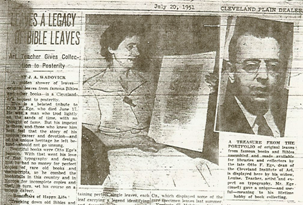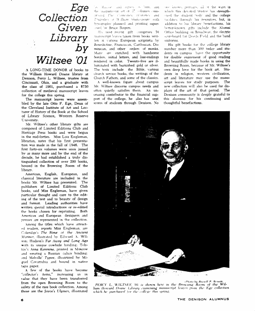Leaves from Medieval Manuscripts
The fifty items are arranged and numbered within their portfolios in generally chronological order; thus the last half-dozen or so postdate the invention of printing. Ege’s identifiers show that his intentional criteria for providing variety among the specimens are driven by six general qualities: kind of manuscript, century of origin, region of origin, type of decoration, type of script, and presence (or absence) of gold. The last designation was clearly an important criterion: when Ege notes “Illuminated,” he seems to be pointing to the chosen specimen leaves themselves. For items so designated he seems especially to have selected for inclusion in all portfolios a leaf from that particular codex that contains gold ink or paint—and has done so to ensure a further element of value, variety, and aesthetic appeal. Evaluating Professor Ege’s method of selection and inclusion of leaves from the component manuscripts, then, becomes a surprisingly complex task: did he generally select forty leaves in relative order within their component manuscripts, and thus create a rather tightly-structured sequence of portfolios vis-à-vis their manuscript sources? Or did he more broadly pick and choose ideal specimen leaves from within his damaged manuscripts? If the latter is the case, of what did his definition of “ideal” consist, and how was it affected by the fragmentary conditions of the manuscripts? Are there decorative themes or emphases peculiar to each specimen set, created within each set through a deliberate selection of leaves? And, most precedental of all, where are the rest of the component manuscripts today? Is it possible to bring them all back into a kind of proximity with one another visually as well as descriptively—and, if so, what does the desire to do so say about the nature of 21st-century medievalism?

Announcement of Louise Ege's inheritance of her husband's collection. (The Plain Dealer, July 20, 1951.)
In keeping with his life-long devotion to the shared appreciation of book art, Otto Ege’s intention was to sell his boxed manuscript portfolios to public and university libraries so that as many people as possible could learn about the history of bookmaking and decoration in the pre-modern era. A corollary intention, of course, was financial gain: textual artifacts are simply much easier to sell, and can almost always be more profitable, when disassembled. But Ege died in June of 1951 before selling any of these particular sets. His widow Louise continued with the commercial plan, and over the next few years sent letters to various colleges and universities announcing the availability of the portfolios at a cost of $750 each. [18] Assuming that all of the sets were sold in this manner and at this price, Mrs. Ege thus realized $30,000 from this single venture—and as I mentioned, the manuscript leaf portfolio was only one of six commercial sets of specimen pages which her husband created; this figure also ignores the rest of the component manuscripts, the 3,000 or so other individual leaves, as well as (of course) the healthy, intact manuscripts which Ege owned.

Announcement of the acquisition of Denison University's portfolio by alumnus Percy Wiltsee.
A large number of sets are located in Ege’s home state of Ohio, but
otherwise they are in institutions of varying sizes and kinds around
North America. In many cases, exact purchase or donation records have
not been kept with the sets and may take further on-site research to
establish: that is, in each of these cases it is not yet certain
whether the institution purchased its set directly from Mrs. Ege, or
acquired it through an intermediary (such as Philip Duschnes) at a
later date. In Denison’s case the acquisition records have
been kept with the portfolio: it was purchased for donation to the
college early in 1956 at a cost of $750 by alumnus, benefactor, and
longtime trustee Percy Wiltsee (Denison University Class of 1901), and
was kept in our Special Collections for several years until being
transferred to the campus art gallery for storage in the 1970s. [19]
In about 1980 half a dozen leaves, mostly from Books of Hours, were removed from Denison’s set and were framed for
hanging; they adorned the walls of our newly-constructed Learning
Resources Center for years. These framed leaves were taken
down and reintegrated into the portfolio for security’s sake in 1994,
but three illuminated leaves (numbers 16, 30, and 31 on the master
list) are presently unaccounted for. Most of the rest of the sets
on the list are complete, though the Boulder and North Carolina sets are also lacking items. The unnumbered set owned by Smith
College was donated by Louise Ege, herself a Smith alumna. [20]
___________________________
[18] Letter from Louise Ege to Denison University President Blair Knapp, December 21, 1955 (Special Collections, William Howard Doane Library, Denison University). Mrs. Ege’s influence can even be found inside the portfolios, such as in the reference to her husband as “the late Otto F. Ege” on the master list of contents.
[19] “Ege Collection Given to Library by Wiltsee ’01,” The Denison Alumnus (1957): 6.
[20] Personal email to the author from Barbara Blumenthal, Mortimer Rare Book Room, Neilson Library, Smith College, November 19, 2001. The portfolio was Mrs. Ege’s 40th reunion gift to the college.